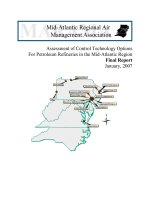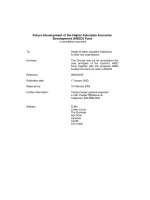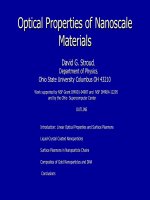future prediction of wireless technology using nano devices
Bạn đang xem bản rút gọn của tài liệu. Xem và tải ngay bản đầy đủ của tài liệu tại đây (699.99 KB, 44 trang )
Optical Properties of Nanoscale
Optical Properties of Nanoscale
Materials
Materials
David G. Stroud
David G. Stroud
,
,
Department of Physics
Department of Physics
,
,
Ohio State University Columbus OH 43210
Ohio State University Columbus OH 43210
Work supported by NSF Grant DMR01-04987 and NSF DMR04-12295
Work supported by NSF Grant DMR01-04987 and NSF DMR04-12295
and by the Ohio Supercomputer Center
and by the Ohio Supercomputer Center
OUTLINE
OUTLINE
Introduction: Linear Optical Properties and Surface Plasmons
Introduction: Linear Optical Properties and Surface Plasmons
Liquid-Crystal Coated Nanoparticles
Liquid-Crystal Coated Nanoparticles
Surface Plasmons in Nanoparticle Chains
Surface Plasmons in Nanoparticle Chains
Composites of Gold Nanoparticles and DNA
Composites of Gold Nanoparticles and DNA
Conclusions
Conclusions
“
“
Labors of the Months” (Norwich, England, ca. 1480).
Labors of the Months” (Norwich, England, ca. 1480).
(The ruby color is probably due to embedded
(The ruby color is probably due to embedded
gold nanoparticles.)
gold nanoparticles.)
The Lycurgus Cup (glass; British
The Lycurgus Cup (glass; British
Museum; 4
Museum; 4
th
th
century A. D.)
century A. D.)
When illuminated from
outside, it appears
green. However, when
Illuminated from within
the cup, it glows red.
Red color is due to very
small amounts of gold
powder (about 40 parts
per million)
Lycurgus Cup illuminated from
Lycurgus Cup illuminated from
within
within
When illuminated from
within, the Lycurgus cup
glows red. The red color
is due to tiny gold
particles embedded in
the glass, which have an
absorption peak at
around 520 nm
What is the origin of the color?
What is the origin of the color?
Answer: ``surface plasmons’’
Answer: ``surface plasmons’’
An SP is a natural oscillation of the electron gas
An SP is a natural oscillation of the electron gas
inside a
inside a
gold
gold
nanosphere
nanosphere
.
.
SP frequency depends on the
SP frequency depends on the
dielectric
dielectric
function
function
of the gold, and the
of the gold, and the
shape
shape
of the nanoparticle.
of the nanoparticle.
electron
sphere
Ionic
background
Electron cloud oscillates with frequency of SP; ions provide restoring
force.
(not to
scale)
Sphere in an applied electric field
Sphere in an applied electric field
Surface plasmon is excited when a long-
Surface plasmon is excited when a long-
wavelength electromagnetic wave is incident on a
wavelength electromagnetic wave is incident on a
metallic sphere.
metallic sphere.
Metallic sphere
EM wave
Incident electric field
is E_0exp(-i w t)
Calculation of SP Frequency
Calculation of SP Frequency
0
0
0
2
3
EE
in
in
εε
ε
+
=
=
0
E
2
2
1
ω
ω
ε
p
in
−=
0
0
21
ε
ω
ω
+
=
applied electric field;
= Drude dielectric function
Surface plasmon
frequency is therefore:
=
0
ε
host dielectric function
(This assumes particle is small compared to wavelength.)
Extinction coefficient, dilute suspension of Au
Extinction coefficient, dilute suspension of Au
particles in acqueous solution
particles in acqueous solution
Crosses: experiment [Elghanian et al, Science 277, 1078 (1997);
Storhoff et al, JACS 120, 1959 (1998). Dashed and full curves:
calculated with and without quantum size corrections [Park and
Stroud, PRB 68, 224201 (2003)].
Control of Surface Plasmons Using
Control of Surface Plasmons Using
Nematic Liquid Crystals
Nematic Liquid Crystals
A nematic liquid crystal (NLC) is a liquid made up of rod-like
A nematic liquid crystal (NLC) is a liquid made up of rod-like
molecules, which can be oriented by an applied dc electric field.
molecules, which can be oriented by an applied dc electric field.
The axis of the NLC is known as the director.
The axis of the NLC is known as the director.
The dielectric tensor of the NLC is anisotropic, with different
The dielectric tensor of the NLC is anisotropic, with different
components parallel and perpendicular to the director.
components parallel and perpendicular to the director.
Schematic of experimental configuration
Experiment to show electric field control of surface plasmon
frequency of gold nanoparticles, using nematic liquid crystals
[J. Muller et al, Appl. Phys. Lett. 81, 171 (2002).]
Measured deviation of surface plasmon resonance energy
Measured deviation of surface plasmon resonance energy
from mean value, vs. angular position of polarization
from mean value, vs. angular position of polarization
analyzer. From Muller et al, Appl. Phys. Lett. 81, 171
analyzer. From Muller et al, Appl. Phys. Lett. 81, 171
(2002).
(2002).
Maximum
splitting: 30
mev (expt).
Plausible configurations of liquid crystal coating: (a)
“uniform” (director always in same direction); (b) “melon”
(two singularities); (c) “baseball” (four singularities;
tetrahedral)
Pictures (b)
and © from
D.R.Nelson,
Nano Lett.
(2002).
Discrete Dipole Approximation
Discrete Dipole Approximation
Purcell & Pennypacker, Ap. J. 186, 175 (1973);
Purcell & Pennypacker, Ap. J. 186, 175 (1973);
Goodman, Draine & Flatau, Opt. Lett. 16, 1198 (1991).
Goodman, Draine & Flatau, Opt. Lett. 16, 1198 (1991).
Idea: break up small particle into small volumes, each of
Idea: break up small particle into small volumes, each of
which carry dipole moment.
which carry dipole moment.
Dipole moment due to local electric field from all the
Dipole moment due to local electric field from all the
other dipoles.
other dipoles.
Calculate total cross-section, using multipole-scattering
Calculate total cross-section, using multipole-scattering
approach.
approach.
Can be used for anisotropic, and absorbing, scatterers.
Can be used for anisotropic, and absorbing, scatterers.
Connect polarizability of small volume to dielectric
Connect polarizability of small volume to dielectric
function, using Clausius-Mossotti approximation
function, using Clausius-Mossotti approximation
Calculated surface plasmon frequency as a function of
Calculated surface plasmon frequency as a function of
metal particle fraction p’ in the coated nanoparticle, for
metal particle fraction p’ in the coated nanoparticle, for
light oriented parallel and perpendicular to nematic
light oriented parallel and perpendicular to nematic
director (uniform configuration) [S. Y. Park and D.
director (uniform configuration) [S. Y. Park and D.
Stroud, Appl. Phys. Lett 85, 2920 (2004)]
Stroud, Appl. Phys. Lett 85, 2920 (2004)]
Computed peak in extinction coefficient versus
Computed peak in extinction coefficient versus
angle of polarization of incident light rel. to coating
angle of polarization of incident light rel. to coating
symmetry axis: three coating morphologies [S. Y.
symmetry axis: three coating morphologies [S. Y.
Park and D. Stroud, unpublished(2004)]
Park and D. Stroud, unpublished(2004)]
(Experimental
splitting at zero
applied field closest
to “melon”
morphology.
Maximum splitting
in expt: 30 meV; in
melon config, 22
mev)
Propagating Waves of Surface
Propagating Waves of Surface
Plasmons in Chains of
Plasmons in Chains of
Nanoparticles
Nanoparticles
A chain of closely spaced metallic nanoparticles
A chain of closely spaced metallic nanoparticles
allows WAVES of surface plasmons to propagate
allows WAVES of surface plasmons to propagate
down the chain.
down the chain.
The waves can be either transverse (T) or
The waves can be either transverse (T) or
longitudinal (L) modes, and can have group
longitudinal (L) modes, and can have group
velocities up to 0.1c or higher.
velocities up to 0.1c or higher.
Studied extensively by Atwater group at Caltech,
Studied extensively by Atwater group at Caltech,
and by other groups at Stanford and elsewhere.
and by other groups at Stanford and elsewhere.
Potentially useful for propagating energy along
Potentially useful for propagating energy along
effectively very narrow waveguides, controlling
effectively very narrow waveguides, controlling
energy flow around corners, etc.
energy flow around corners, etc.
Nanoparticle chain
Nanoparticle chain
Surface plasmons can propagate along a periodic
Surface plasmons can propagate along a periodic
chain of metallic nanoparticles (above)
chain of metallic nanoparticles (above)
a
d
Photon STM Image of a Chain of
Photon STM Image of a Chain of
Au nanoparticles [from Krenn et
Au nanoparticles [from Krenn et
al, PRL 82, 2590 (1999)]
al, PRL 82, 2590 (1999)]
Individual particles: 100x100x40 nm, separated by 100
Individual particles: 100x100x40 nm, separated by 100
nm and deposited on an ITO substrate. Sphere at end
nm and deposited on an ITO substrate. Sphere at end
of waveguide is excited using the tip of near-field
of waveguide is excited using the tip of near-field
scanning optical microscope (NSOM), and wave is
scanning optical microscope (NSOM), and wave is
detected using fluorescent nanospheres.
detected using fluorescent nanospheres.
Calculation of SP modes in
Calculation of SP modes in
nanoparticle chain
nanoparticle chain
In the dipole approximation, there are
In the dipole approximation, there are
three
three
SP modes
SP modes
on each sphere, two polarized
on each sphere, two polarized
perpendicular
perpendicular
to chain,
to chain,
and one polarized
and one polarized
parallel
parallel
. The propagating waves are
. The propagating waves are
linear combinations of these modes on different spheres.
linear combinations of these modes on different spheres.
In our calculation,
In our calculation,
we
we
include
include
all
all
multipoles
multipoles
, not just
, not just
dipoles. Then there are a infinite number of branches,
dipoles. Then there are a infinite number of branches,
but only lowest three travel with substantial group
but only lowest three travel with substantial group
velocity.
velocity.
Can be compared to
Can be compared to
nanoplasmonic
nanoplasmonic
experiments
experiments
, as
, as
discussed by Brongersma et al [Phys. Rev. B62, 16356
discussed by Brongersma et al [Phys. Rev. B62, 16356
(2000) and S. A. Maier et al [Nature Materials 2, 229
(2000) and S. A. Maier et al [Nature Materials 2, 229
(2003)]
(2003)]
Calculated dispersions relations for gold nanoparticle
Calculated dispersions relations for gold nanoparticle
chain, including only dipole-dipole coupling in quasistatic
chain, including only dipole-dipole coupling in quasistatic
approximation [S. A. Maier et al, Adv. Mat. 13, 1501
approximation [S. A. Maier et al, Adv. Mat. 13, 1501
(2001)]
(2001)]
(L and T denote longitudinal and transverse modes)
Surface plasmon dispersion relations, nanoparticle
Surface plasmon dispersion relations, nanoparticle
chain, including ALL multipole moments [Park and
chain, including ALL multipole moments [Park and
Stroud, Phys. Rev. B69, 125418 (2004)]
Stroud, Phys. Rev. B69, 125418 (2004)]
Calculated surface plasmon dispersion relations (left) and
Calculated surface plasmon dispersion relations (left) and
group velocity for energy propagation in the lowest two
group velocity for energy propagation in the lowest two
bands.
bands.
Solid
Solid
curves: L
curves: L
modes
modes
;
;
dotted
dotted
curves: T
curves: T
modes
modes
.
.
Light curves;
Light curves;
dipole
dipole
approximation; dark curves, including
approximation; dark curves, including
all
all
multipoles
multipoles
. a/d=0.45, a=
. a/d=0.45, a=
particle
particle
radius
radius
; d=
; d=
particle
particle
separation
separation
T
L
L
T
L
L
T
T
Effects of Higher Multipoles
Effects of Higher Multipoles
Strong distortion of dispersion relation,
Strong distortion of dispersion relation,
compared to dipole-dipole interaction
compared to dipole-dipole interaction
Percolation effect when gold particles approach
Percolation effect when gold particles approach
contact: frequency of L branch approaches 0 at
contact: frequency of L branch approaches 0 at
k=0
k=0
Single-particle damping can be included. Still to
Single-particle damping can be included. Still to
include: radiation corrections. Also omitted:
include: radiation corrections. Also omitted:
disorder (in shape, size, interparticle distance).
disorder (in shape, size, interparticle distance).
Calculated dispersion
relations s(k) for L and
T modes in a chain of
nanoparticles, plotted
vs. k for (a-f)
a/d=0.25,0.33,0.4,0.45,
0.49,0.5 (spheres
touching). a=sphere
radius, d=distance
between sphere centers.
Open symbols: point
dipole approx. The
symbol
1
)/1(
−
−=
sm
s
εε
[Park and Stroud, PRB69,
125418 (2004)]
Linker
DNA
Melting and Optical Properties of
Melting and Optical Properties of
Gold/DNA Nanocomposites
Gold/DNA Nanocomposites
[Schematic from R. Elghanian et al, Science
277, 1078 (1997)]
At high T, single Au
particles float in
aqueous solution,
with DNA strands
attached (via thiol
groups). At lower
T, particles freeze
into a clump.
Freezing is
detectable optically.
Observed absorptance:
Observed absorptance:
comparison of unlinked and
comparison of unlinked and
aggregated Au nanoparticles
aggregated Au nanoparticles
Absorptance of unlinked and aggregated Au nanoparticles, as
Absorptance of unlinked and aggregated Au nanoparticles, as
measured by Storhoff et al
measured by Storhoff et al
[J. Am. Chem. Soc. 120, 1959 (1998)]
[J. Am. Chem. Soc. 120, 1959 (1998)]









